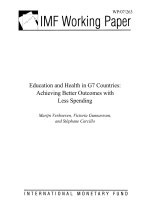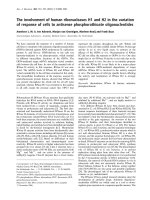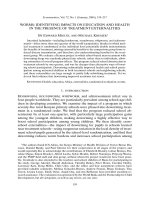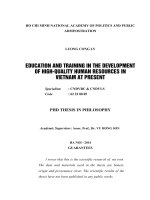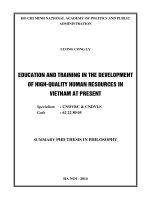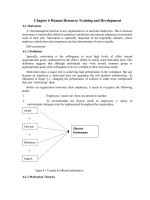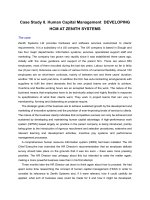Lecture Economic development - Chapter 8: Human capital: Education and health in economic development
Bạn đang xem bản rút gọn của tài liệu. Xem và tải ngay bản đầy đủ của tài liệu tại đây (1003.07 KB, 33 trang )
Chapter 8
Human Capital:
Education and
Health in
Economic
Development
Copyright © 2009 Pearson Addison-Wesley. All rights reserved.
Development & Human Capital
• Health and education are investments in
human capital to improve labor productivity
• Investment in human capital is a major
determinant of growth and development
Copyright © 2009 Pearson Addison
Wesley. All rights reserved.
82
Development & Human Capital
• Investment in health increases the return to
investment in education
• Investment in education increases the
return to investment in health
Copyright © 2009 Pearson Addison
Wesley. All rights reserved.
83
Development & Human Capital
• Economic growth would not lead to substantial
increases in investment in children’s education
and health
• Better educated mothers tend to have educated
and healthy children
• Market failure in education and health requires
policy action
Copyright © 2009 Pearson Addison
Wesley. All rights reserved.
84
Determinants of Education Demand
• Wage or income differential paid to workers
with various levels of education
• Probability of success in finding a job in the
formal sector
• Direct private cost of education (e.g., tuition)
• Indirect or opportunity cost of education (i.e.,
Copyright © 2009 Pearson Addison
foregone income)
Wesley. All rights reserved.
85
Return of Investment in Education
• Initial investments in education lead to a
stream of higher future income
• The present discounted value of this stream
of future income is compared to the cost of
education
Copyright © 2009 Pearson Addison
Wesley. All rights reserved.
86
The Economics of Education
Copyright © 2009 Pearson Addison
Wesley. All rights reserved.
87
Age-earnings Profiles by Level of
Education: Venezuela, 1989
Copyright © 2009 Pearson Addison
Wesley. All rights reserved.
88
Child Labor in LDCs
• Some 120 million children work full-time
• Some 150 million children work part-time
• Of these 250 million working children
– 61% or 153 million in Asia
– 32% or 80 million in Africa
– 7% or 17 million in Latin America
Copyright © 2009 Pearson Addison
Wesley. All rights reserved.
89
Child Labor in LDCs
• Child labor is a common practice in LDCs
labor markets
• The problem may be modeled using the
“multiple equilibria” approach
• Government intervention is needed to move
to a ‘better’ equilibrium
Copyright © 2009 Pearson Addison
Wesley. All rights reserved.
810
Market for Child Labor
Adult Labor Supply
Wage
WE1
WH
WL
A
E1
B
WE2
A’
Copyright © 2009 Pearson Addison
Wesley. All rights reserved.
Adult & Child Labor
T Supply
• At WE1 labor supply is AA’
• As children enter the market, wage falls
• At WL adult and child labor supply is TT’
• At WE2, OA’ of adult and A’T’ children
are employed; a ban on child labor
C • moves E2 to E1
The S-shaped curve is supply of child
E2 labor between these wages: E1BCE2
T’
Demand for Labor
Employment
811
The Education Gender Gap
Females receive less education than males in LDCs. To close the gap
• The rate of return on education is higher for female than male
• Female education increases productivity and lowers fertility
• Educated mothers raise educated children
• Female education helps break the vicious cycle of poverty and
inadequate schooling for women
Copyright © 2009 Pearson Addison
Wesley. All rights reserved.
812
Male and Female Education
Rates, 2004
Copyright © 2009 Pearson Addison
Wesley. All rights reserved.
813
The Education Gender Gap
Consequences of gender bias in health and
education
• Economic incentives
• Cultural setting
• Increase in family income does not always
lead to better health and education
Copyright © 2009 Pearson Addison
Wesley. All rights reserved.
814
Social vs. Private Returns of Education
• Social and private returns of education are
higher in LDCs than MDCs
• Private returns are higher than social returns
• Social and private returns are higher for
primary than secondary and higher
education
Copyright © 2009 Pearson Addison
Wesley. All rights reserved.
815
Rate of Return to Investment in
Education
Copyright © 2009 Pearson Addison
Wesley. All rights reserved.
816
Optimal Level of Education
• Optimality criterion for education: maximum
difference between returns and costs
• Social: the optimal level of education is “primary”
where costs are subsidized and returns are high
• Private: the optimal level of education is “higher”
where costs are heavily subsidized and returns are
very high
Copyright © 2009 Pearson Addison
Wesley. All rights reserved.
817
Social Costs & Returns
Social Returns
Costs/Returns
Tertiary
Social Costs
Secondary
Primary
Public decision: Invest in primary education
Years of schooling completed
Copyright © 2009 Pearson Addison
Wesley. All rights reserved.
818
Private Costs & Returns
Private Returns
Costs/Returns
Secondary
Tertiary
Private Costs
Primary
Private decision: Invest in higher education
Years of schooling completed
Copyright © 2009 Pearson Addison
Wesley. All rights reserved.
819
Education and Development
• Distribution of education
– Lorenz curves for the distribution of education
• Education Inequality and Poverty
Copyright © 2009 Pearson Addison
Wesley. All rights reserved.
820
Lorenz Curves for Education
in India and South Korea, 1990
Copyright © 2009 Pearson Addison
Wesley. All rights reserved.
821
Gini Coefficients for Education in
85 Countries, 1990
Copyright © 2009 Pearson Addison
Wesley. All rights reserved.
822
Health-Care and Development
Measurement and distribution
• Life expectancy at birth
• Child mortality
• Malnutrition and hunger
Copyright © 2009 Pearson Addison
Wesley. All rights reserved.
823
Life Expectancy in World Regions
Copyright © 2009 Pearson Addison
Wesley. All rights reserved.
824
Under-5 Mortality Rates in Various
World Regions
Copyright © 2009 Pearson Addison
Wesley. All rights reserved.
825


